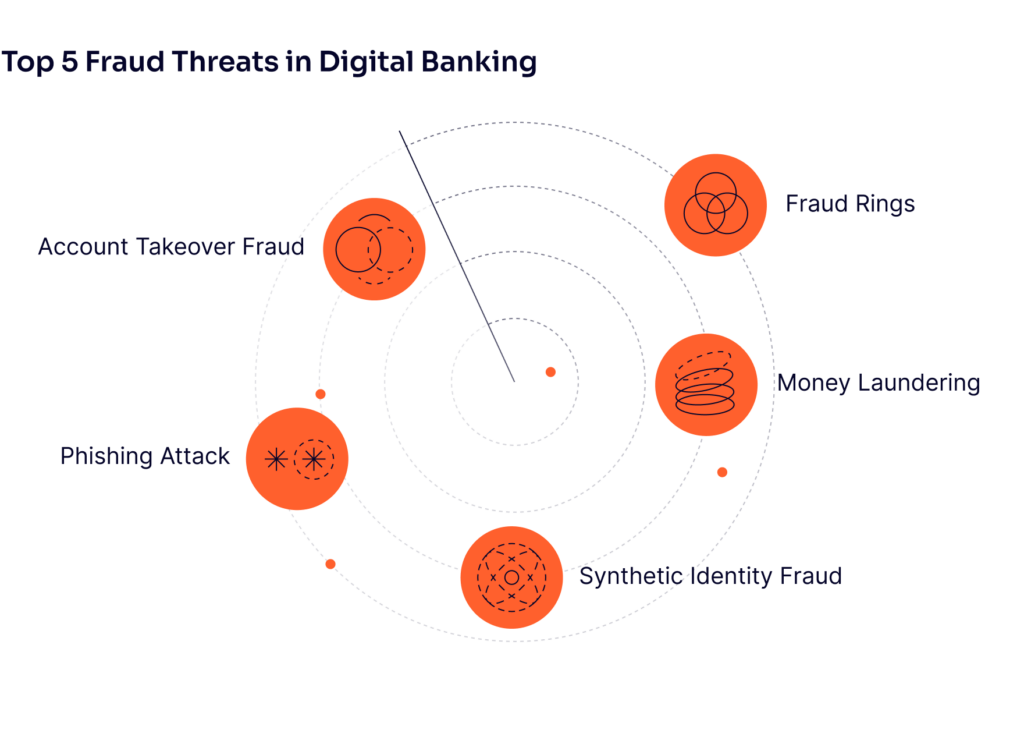The digital banking sector has transformed how consumers manage their finances, with 71% of customers now preferring to handle their bank accounts through mobile apps or computers. This shift toward convenience has altered financial services, allowing consumers to access banking anytime, anywhere. However, as digital banking grows, so do the threats posed by increasingly sophisticated fraudsters – quick to exploit vulnerabilities within these platforms, making it critical for digital banks to stay ahead of current and emerging threats.
5 Most Common Types of Fraud in Digital Banking
Understanding the most common fraud vectors targeting digital banking is essential to protect both banks and their customers. Below are the top five threats that digital banks must guard against:
1. Account Takeover Fraud
Account takeover fraud (ATO) is one of the most prevalent threats in digital banking. In an ATO attack, fraudsters gain unauthorized access to a customer’s banking account, often obtaining login credentials through phishing campaigns, social engineering or data breaches. Once they have access, fraudsters transfer funds, make unauthorized purchases and even steal additional personally identifiable information (PII) for future fraudulent use.
Since digital banks offer easy access via mobile and web applications, customers may only recognize unusual account activity once significant damage has been done. Real-time fraud detection, device intelligence and device fingerprinting solutions are designed to flag unusual account behaviors, such as login attempts from suspicious devices or unexpected transaction patterns, helping mitigate ATO attacks before they escalate.
2. Phishing Attacks
A formidable and ever-present threat in digital banking, phishing attacks involve fraudsters mimicking legitimate institutions via emails, SMS or fake websites to deceive customers into revealing sensitive information such as login credentials or banking details. In 2023, phishing accounted for 73% of digital banking fraud cases.
Digital banking customers are particularly vulnerable due to the very nature of their interactions – they are online and often without face-to-face confirmation of who they are dealing with. Phishing attacks have become increasingly sophisticated, with fake websites and email addresses closely resembling legitimate financial institutions in recent years. Educating customers on identifying phishing attempts and implementing robust email filtering and monitoring solutions are important in defending against this ubiquitous threat.
3. Synthetic Identity Fraud
Synthetic identity fraud is another growing problem for digital banks. Fraudsters fabricate identities by combining real and false information, enabling them to bypass initial verification checks, particularly in online banking environments where physical verification is often less rigorous.
Once a synthetic identity has been created, fraudsters use it to apply for loans, credit cards and other financial products. They may build a positive credit history for months or even years before eventually defaulting on large amounts of credit. The complexity of synthetic identity fraud, the blending of partially true with fictitious information, makes it particularly challenging to detect.
4. Money Laundering
Money laundering in banking remains a persistent challenge, especially for digital institutions operating across borders. As transactions become faster and more global, criminals exploit these systems to move illicit funds through complex layers of transfers, making it harder to spot suspicious activity in time.
To prevent money laundering, digital banks must implement comprehensive Anti-Money Laundering (AML) measures, including monitoring large or frequent transactions, flagging transactions from high-risk regions and conducting KYC (Know Your Customer) checks.
5. Fraud Rings
Fraud rings involve organized groups of criminals working together to perpetrate large-scale, coordinated attacks on digital banks. These rings are often responsible for a significant portion of the financial damage caused by fraud, as they can parallel deploy sophisticated schemes, such as bust-out fraud, ATO and synthetic identity fraud.
Fraud rings often exploit digital banks’ lack of physical infrastructure to exploit vulnerabilities in their online verification processes. They may create multiple fraudulent accounts to launder money or steal funds through large-scale coordinated efforts. Detecting and dismantling fraud rings requires advanced pattern recognition and multi-layered detection systems. SEON’s machine learning and device intelligence technologies can identify connections between seemingly unrelated accounts and transactions, helping to disrupt the activities of fraud rings before they cause substantial financial damage.

How to Protect Your Digital Bank From Fraud
To effectively protect digital banks from fraud, it’s essential to implement a multi-layered security strategy that addresses the unique challenges an online financial environment poses. Start by adopting real-time transaction monitoring systems that can detect suspicious activities and anomalies as they happen. Advanced technologies like machine learning (ML) and artificial intelligence (AI) can identify complex fraud patterns, such as ATOs, synthetic identities and coordinated fraud rings. Since these tools continuously learn from new data, they can adapt quickly to emerging fraud tactics and reduce false positives, ensuring smoother customer experiences while maintaining strong security.
In addition to monitoring transactions, rigorous Know Your Customer (KYC) protocols and AML compliance are similarly crucial measures. KYC procedures can be bolstered by digital footprint analysis, device intelligence and behavioral biometrics to enhance identity verification, especially during account opening and onboarding. Integrating AML tools into transaction monitoring systems can identify high-risk activities like unusual transaction volumes, transactions from sanctioned countries, or shell companies’ use for laundering money. By combining KYC and AML with continuous monitoring and automated alerts, digital banks can catch fraudulent activities before they escalate.
Finally, fostering customer awareness and education about standard fraud techniques, such as phishing and social engineering, is indispensable to any defense strategy. Fraud prevention is a shared responsibility between the bank and its customers, and well-informed users are less likely to fall victim to phishing scams or identity theft. Regularly updating customers on the latest fraud tactics and promoting best practices, like enabling multi-factor authentication (MFA) and monitoring account activity, strengthens their protection and helps build a trusted and secure banking environment.
Importance of Compliance and Regulatory Measures in Digital Banking Fraud Prevention
As digital banking expands globally, adhering to evolving regulatory requirements becomes critical for protecting financial institutions against fraud. Compliance protocols, such as AML regulations, KYC protocols and sanctions screening, are foundational to fraud prevention efforts. Non-compliance can lead to significant fines, legal consequences and reputational damage, intensifying the financial impacts of fraud.
The challenge of compliance in digital banking lies in its complex nature, driven by the diversity of online financial transactions. Digital banks must adeptly navigate varying local and international regulations while ensuring seamless customer interactions. Employing robust compliance tools – automated AML checks, real-time monitoring of suspicious transactions and regular audits – helps these banks uphold regulatory standards and actively combat fraud.
Moreover, staying current with regulatory updates, such as shifts in data privacy laws or new anti-fraud regulations, is essential. This proactive approach allows digital banks to continually refine their strategies, enhancing their fraud prevention capabilities and compliance posture.
Discover essential strategies and collaborative approaches to protect your digital bank from fraud risks while expanding into new markets—download the guide now to stay ahead of emerging threats.
Download our guide
How SEON Helps Digital Banks Fight Fraud
SEON empowers digital banks to combat fraud effectively by integrating advanced, real-time fraud prevention tools that address the sector’s specific challenges. Our solution is engineered to provide a comprehensive suite of services that cater to both established digital banks with existing systems and emerging digital banks developing their infrastructures.
SEON enhances existing fraud prevention and compliance systems for institutions with substantial market presence by delivering superior efficiency and cost-effectiveness. It integrates seamlessly to boost the capabilities of KYC and AML processes without disrupting ongoing operations. This is particularly valuable for mature digital banks that require sophisticated tools to supplement their established systems, ensuring they remain ahead of advanced fraud techniques and regulatory changes.
For emerging digital banks and smaller financial entities, often without comprehensive compliance infrastructures, SEON can simplify AML transaction monitoring and provide robust reporting tools essential for meeting regulatory demands. By minimizing resource overload, SEON empowers digital banks to implement effective fraud prevention strategies from the start, fostering secure growth. Maintaining a secure, compliant and customer-friendly environment is crucial for success in today’s digital landscape. By providing a comprehensive blend of prevention, detection and compliance capabilities, SEON ensures that digital banks are thoroughly prepared to handle both common and complex threats, ranging from account takeovers and phishing to sophisticated fraud rings and money laundering activities.
You might be interested in:
- SEON: Guide – Collaborative Strategies for Mitigating Fraud Risks in Digital Banking Expansion
- SEON: Guide – Onboarding Risk Reduction in Digital Banking
Sources:
- Bankrate: Digital Banking Trends in 2024
- PYMNTS: Fending Off Fraud in Digital Banking






